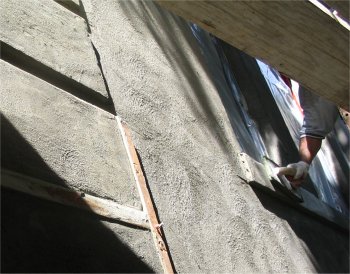New color coat popping off
Help. I recently paid to have my house's trim painted and a color coat with spanish lace stucco texture on my home. Needless to say I have been crying for many days. My color coat with spanish lace stucco texture is cracked and falling off. If you rub your hand over it everything falls off. Can you tell me what went wrong and what I have to do to remedy the situation. I did pay to have a professional do it. However, I now believe that they apparently did not know what they were doing. Can you offer me any suggestions?.
Another reader writes:
Can you stucco over existing stucco. We purchased a new home and when the stucco was put on, the wrong color was put on. The company then came and fogged over the stucco with the new color, however, this is now chipping when you touch it) and running (when it rain or any water comes into contact with it). Now this company wants to come and stucco over what is there now. Is this okay or should we request that they remove the stucco and scratch coat and do it properly. My concern is that if the fogging is chipping and running can the new stucco bond to it properly.
This is typical of messages that I get all the time. First, before hiring someone to resurface your house insist on going by a looking at a job they have done like your house, if not two or three. An hour or two of riding around may save you a lot of grief.
The reason that the new color coat fails to bond or turns crumbly is that white (or color) cement will not bond to white portland cement, at least with out additional additives or methods of making white portland bond.

Old stucco is coated with a bonding coat and rubbed with a rubber float.
The shadows ruined my pictures but I hope you can see a hand with a rubber float at the window sill. This trowel on method is a lot of work, but note how we filled in the missing quoins with the same mix.
The reason white portland and sand (with or without color) won't bond to white portland and sand is that it is way too porous- water is absorbed too rapidly from the new mortar to allow the mortar to soak in an set up. In plastering this is called suction, or the fact that water is sucked out of one material into the other. White portland is what is called a "high suction" substrate, or surface. More about controlling suction in the future. Wetting down the old color doesn't seem to do much good. It just has too much suction.
There are several methods of re-color coating stucco. I am going to tell you my method and mention some others.
The new color coat or portland cement mortar can be bonded using an acrylic in the mortar, such as Acryl60, Milestone or Flex con. This can be mixed into the new finish at least 25% with water (we go 50%) and applied.
A better method is to apply a bonding coat before the new finish. A bonding coat can be just a mixture of acrylic liquid and gray portland (no sand) applied with a stiff broom or a brush, leaving the surface rough before applying the finish. Our method is mixing gray portland with a medium sand and a mix of acrylic and water. The mortar is troweled on and then the surface is roughed up by rubbing with a rubber float. This method allows holes and other irregularities to be filled in, leaving a nice even surface for the finish coat.
Another advantage of using a bonding coat instead of just a color coat on top is uniformity of color and uniformity of suction. A new color coat over a rough spanish texture will usually read through the finish, the deep areas being whiter.
Other methods: In California, and other places, the old color coat is sometimes sandblasted completely off before a new color coat is applied. An old method that still is widely used in Mexico and other places is a portland cement paste (click here for details), or the wall is dashed first with a brush using sanded portland mortar.